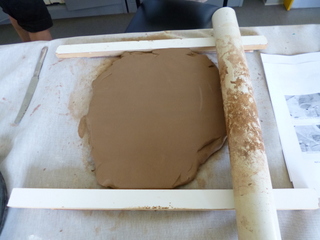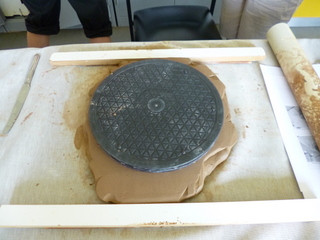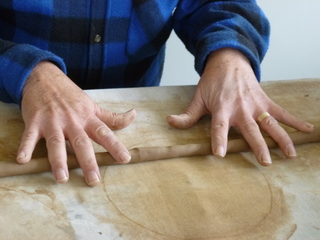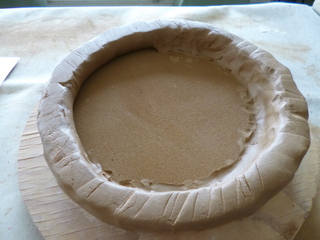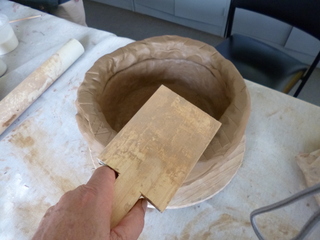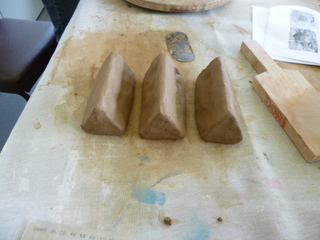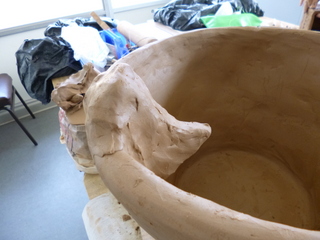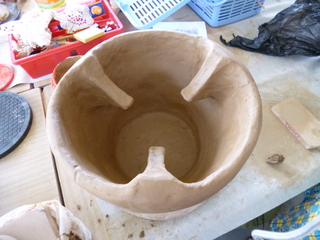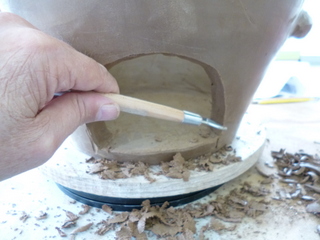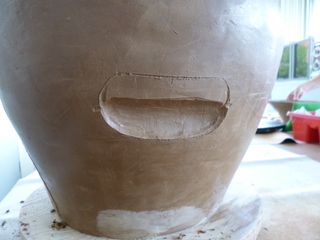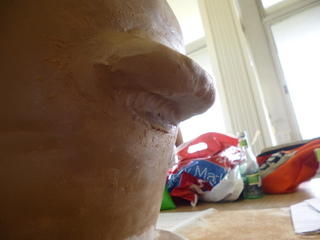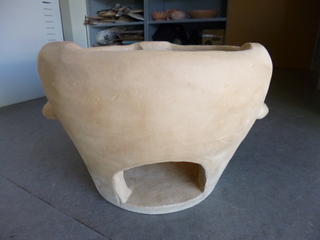This is something that you can make from the clay you prepare yourself and then you can use it to cook your food using sticks and branches from around your local area. It won’t be as efficient as a rocket stove but it will be more efficient that three stones supporting s cooking pot over a fire and you can make it from local materials.
To start out roll some clay out about 20 to 25mm thick and then cut out a round to form the base of the stove, I used my 250mm diameter lazy Susan to act as the template. Once you have the base, knead up and roll some more clay to form a roll about 25mm thick, lay it around the edge of the base and give it a bang with a wooden bat to make sure the two bits of clay meld together. Then smooth it over the inside and outside so that rather than looking like a round bit sitting on a flat bit with your fingers and make sure there are all smooth lines.
From this point on it is just a case of building up the stove roll by roll until it is a high as you want to make it and flaring slightly outwards, banging and smoothing each roll in as you go. If you leave the project for any time, wrap it up in two or three layers of plastic or plastic garbage bags to stop it drying out too much. If the weather is hot or you leave it for more than a week or two you will probably need to score and slip the top of the clay before putting on the next roll once you come back to it.
The finished dimensions for my stove were about 250mm high and about 350mm wide at the top, but the dimensions are really up to you and the size of pot(s) you will be using on your new wood stove. Remember that when stove is dried and fired (if you go that far) it will be 10% smaller!
If your stove is built up as high as you want, while not being strictly necessary it is good to give it a few taps all over the outside with your bat and smooth it off inside and out with a rubber kidney. While making it look nicer, but both of these processes will cause the surface of the clay to be denser and stronger so it is worth a bit of extra time to get this right.
With the main part of the stove built, the next three operations will be to put on the pot supports, cut the hole in the side for the fuel to go in and put the handles on the side so it is indeed a “portable” stove. The finished fired weight of my stove is a bit over 10 kilograms so a couple of handles for carrying are really handy!
There are three pot supports, for the same reason that spinning wheels have three legs so that they are stable on an uneven floor, three supports means you don’t have to have them all on exactly the same level for the pot to be stable. I made three clay triangular prism shapes, set them on the rim of the stove with the apex facing down, then moulded them in to the inside of the stove. They ended up like 3 ski jumps so that a number of different diameter pots can sit centrally on them and remain stable. I use the rubber kidney on all sides to smooth them off to the finished the profile.
The hole was comparatively easy, in an area of the side between two pot supports I carved out the edge of what seemed to be a reasonable sized hole and then used my pottery knife (ie recycled butter knife) to cut and remove the excess clay. The hole is 120mm wide by 90mm high and seems to do the job. I did let it dry out for a while and harden up, then used a surform tool to tidy up the opening and round things off somewhat.
The last thing to do was put in the handles, the majority of the clay would be contributed by the clay I cut out of the hole where the wood goes in. I marked out an ellipse 120mm long and about 50mm wide on each side of the stove so that the hole for the wood was in the middle. I then cut a central line down the ellipse and dug out some clay from the bottom half to form a shallow depression. I then formed a couple of clay handles and attached them to the side of the stove and smoothed them in so that they were well blended into the stove.
Once all this was finished it took 4-5 hours to do all up, but I wasn’t in any hurry and took it in 2 hour sessions, I then set it aside for 3 weeks to dry. I was intending to use it in a dried but not fired state but the lady where I do my potting convinced me to fire it in a commercial kiln. It came out pretty well and I am very happy with it. The big things are to make sure the object is DRY and then take the kiln up to temperature s-l-o-w-l-y!



